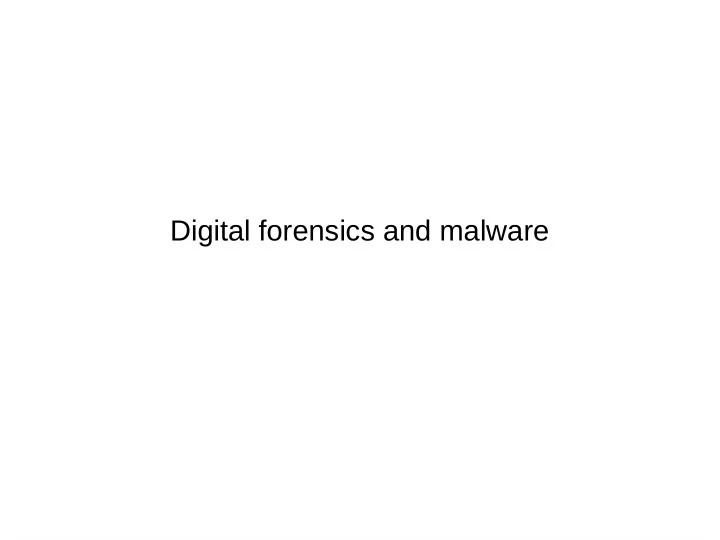

Digital forensics and malware
Digital forensics ● According to Wikipedia, you could be looking for: attribution, alibis and statements, intent, evaluation of source, document authentication ● File carving ( e.g. , bifragment gap carving) – Electron microscopes ● Memory forensics (Volatility) ● Network forensics (PCAPs, NetFlow records, NIDS logs) ● Database forensics ● Timestamps in document or log file analysis ● Steganography ● Digital forensic processes ● Benford's law
File carving Alessio Sbarbaro User_talk:Yoggysot - Own work
Memory forensics
Steganography From https://www.tech2hack.com/steganography-hide-data-in-audio-video-image-files/
Forensics tools ● File carvers – E.g. , Scalpel and foremost ● Log parsers ● Parsers/viewers for different kinds of files – SQLite, EXIF, etc. ● Linux commands that might be useful: – file, exif, sqlite3, losetup, mount, dd, ssdeep, grep, strings
Malware ● Cryptovirology by Young and Yung ● The Art of Computer Virus Research and Defense by Szor – Common theme since the turn of the millennium: stay in memory and don't go out to disk ● Elk Cloner in 1981 (Skrenta) ● “Virus” coined by Cohen in 1983 (“Information only has meaning in that it is subject to interpretation”) – https://web.eecs.umich.edu/~aprakash/eecs588/handouts/cohen-viruses.html ● “Worm” came from John Brunner's The Shockwave Rider in 1975 – Creeper in 1971 for TENEX systems – ANIMAL in 1975 – Morris Worm in 1988 – Code Red in 2001
Interesting types of malware ● Macroviruses – “On error resume next” ● Botnets – Command and Control (C&C), from IRC and hierarchical to fastflux and beyond ● Targeted threats and “RATs” – E.g., Tibetan exile community, Syria/Egypt, Mexico – Google “Citizen Lab” or watch “Black Code”
Malware analysis ● Static vs. dynamic ● IDA Pro, Ollydbg, etc. ● Cuckoo Sandbox ● Decompilation ● Armoring, packing, etc.
Stuxnet ● Attacked Iranian nuclear program ● Multiple ways of spreading ● Attempt to limit spread ● Not as buggy as malware typically is
Anomaly detection ● A Sense of Self for Unix Processes (Forrest et al. in 1996)
Resources ● Practical Malware Analysis by Honig and Sikorski ● http://www.forensicswiki.org/wiki/Tools
Conferences you should check out ● IEEE Symposium on Security and Privacy (Oakland) ● USENIX Security Symposium – Also check out the workshops like FOCI and WOOT ● ACM Conference on Computer and Communications Security (CCS) ● Network and Distributed System Security Symposium (NDSS) ● Privacy-Enhancing Technologies Symposium (PETS) – Also PoPETS ● Also RAID for intrusion detection, DFRWS for forensics, CSF for policy and theory, Eurocrypt and Crypto, Blackhat, DEFCON, phrack, 2600 magazine, WPES and WEIS
Recommend
More recommend